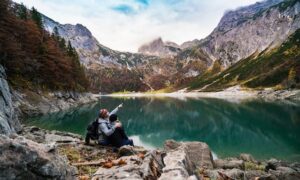
You may not be a hardcore hiker, but a willingness to get out of the comfort zone of your home and explore the world on foot is all that is needed to go on a hiking expedition. While it may not be everyone’s cup of tea to traverse the gruelling inclines and declines of the hiking trails, it is definitely one of the most rewarding experiences you can get outdoors.
Just imagine yourself taking a saunter along the rocky ledges leading to the flat-topped mountain where you get an amazing sunset view of the rustic coastlines. During your journey, you never know what you may stumble upon — it could be the ruins of an ancient fortress in the middle of the jungle, a breathtaking mountain scenery, or a mystical forest that unravels its secrets as you go deeper. That’s why hiking is more than passion or addiction to many adventurers.
Take a brisk walk or a casual stroll — it’s your choice, but you’ll know why hiking along these trails are more rewarding than you can imagine!
Here are some of the most coveted hiking destinations that you can truly call the Hiker’s paradises on earth.
1) Inca Trail, Peru
Of all the hiking trails in the world, the Inca Trail to the ancient city of Machu Picchu has to be one of the best for adventure junkies and those who are up for a challenge. The hike begins from Cusco by following an ancient trail built by the Incas that leads up to the serene, mind-boggling scenery of the Andean mountains from up above.
Traversing the mountain passes and the incredible Inca ruins — Sun Gate, Runkurakay, Llactapata, Phuyupatamarca, Wiñay Wayna, and Sayacmarca — the 80+ km trek finally descends down to the Amazon valleys. If you’re down for this amazing trek, be sure to book in advance, since there is a limit to the number of visitors allowed each day. The trail is closed in February each year for cleaning and maintenance, so be sure not to plan your trip during that month.
2) Te Araroa Trail, New Zealand
If long trails lasting for at least a couple of months is what you’re looking for, Te Araroa Trail in New Zealand has something special for you. The Te Araroa is defined by its characteristic volcanoes, rustic farmlands, forested ranges, and rugged coastlines, traditional Maori marae — everything so surreal and ‘out of the imagination’ that you’ll easily lose track of time exploring the serene wilderness and idyllic villages you pass through.
A 3000-km trail that stretches from Cape Reinga in the north to Bluff in the south, it would take more than 50 days per island if you’re going for a thorough hiking. That means, a complete tramp would take around 5 complete months. However, section tramps are also available that can last for a few days to a few weeks where you’ll either be hiking up north or down south. The best time to hike this amazing trail would be from late September to early April each year. We also recommend not to hike at any other time, as the unpredictable NZ weather can sometimes be quite harsh. Even in ideal conditions, water crossings and the quickly changing weather conditions are the most dangerous elements you’ll have to expect.
3) Kilimanjaro, Tanzania
The world’s tallest freestanding mountain and Africa’s highest peak, Kilimanjaro can’t escape any of the serious hiker’s bucket list. The view of the majestic snow-capped mountain standing alone, but tall, in the middle of Tanzania’s Kilimanjaro National Park itself is surreal and otherworldly. Think about how amazing the experience would be when you’re hiking through the lush green forests and Alpine deserts to the top of the peak, whilst sleeping under the starry African sky and walking across the Arrow glacier!
Hiking Kilimanjaro comes with its own set of risks. If you’re up for a real challenge to climb it multiple routes till you reach the summit, Kilimanjaro can be a treat for both beginners as well as advanced hikers. However, an intense preparation is required months before starting the hike. You will also need to be mentally prepared to hike in conditions with half the oxygen you’re used to, at the sea level. The best way to get acclimatized to that is through hiking it slowly and at a steady pace. There are two seasons for the best trekking experience — January to March and June to October. While the former season tends to be a bit colder, the latter is a lot quieter. All the other months are wet or extremely cold seasons, making it unsuitable for hiking.
4) Kungsleden, Sweden
The 440 km-long Kungsleden Trail is the best-known hiking trail of Sweden. We don’t have to brag about Sweden’s natural beauty, and you definitely know why. The spectacular snow-capped mountainscapes, easy-going arctic terrains, uplifting weather that dramatically modifies the landscape beauty, the birch forests, occasional streams, as well as the elaborate network of mountain huts to rest and unwind make Kungsleden a choice destination for hikers of all levels, photographers, and nature lovers.
The Kungsleden trail has many routes, but the Abisko-Kebnekaise route is one of the classics. Anyone in a good physical condition can hike the Kungsleden trail. High & mid-summer and autumn offer the ideal hiking conditions. In the other seasons, you have to inquire whether the huts are open before making the commitment.
5) Everest Base Camp Trek, Nepal
The highest peak and one of the most famous mountains on the planet, Mt. Everest has captivated a million hikers dreaming to tame this wild & stubborn snow-capped mountain. The Everest Base Camp trek is a quite achievable endeavour suitable for everyone, just to give you a sample of how majestic Mt. Everest is.
Work your way through breathtaking mountain sceneries, glaciers, Sherpa villages, Buddhist monasteries, and museums to the Everest Base Camp. The best seasons to plan your trek is March-May (summer) and September-December (winter). While you can, literally, do nothing to prepare yourself for the trek to an altitude of 5545 metres above the sea level which includes covering extreme hills and rough terrains, the trek is quite achievable for a person with an average fitness — taking it slow and stead to get accustomed to the weather and altitude is the key.
6) Mont Blanc Trek, Europe
A trek that takes you along the majestic Alps mountain ranges and covering three beautiful countries — France, Italy, and Switzerland, the Mont Blanc is one of the most premier hiking trails in the world. Often referred to as Tour Du Mont Blanc, this high-altitude trek leads you to Mont Blanc, traversing high mountain passes, the serene Alpine meadows, a series of stunning glaciers, the steep downhills, and the glorious valleys of this incredibly beautiful region in Europe. A good fitness level is required to hike along this 170 km-long trail, but there are a lot of mountain huts to give you shelter and rest along with way. The best seasons to hike Mont Blanc are July & August, but the huts will be open from mid-June to early September to accommodate early or late hikers.
7) Pacific Crest Trail, USA
The Pacific Crest Trail truly unravels the beauty of the American landscapes and is a hotspot for thousands of hikers as well as equestrians. Spanning 4265 km from Mexico to Canada, this incredibly long hiking trail takes you through California, Oregon, and Washington. On the way, you’ll be passing through breathtakingly beautiful deserts, glaciers, cascade ranges, deep forests, as well as the volcanic peaks in the western part of the USA. You should be wary of a variety of dangers on the way, of which snowfalls, rattlesnakes, heatstrokes, and corneal flash burns due to the snow glares are quite common. If you’re a through hiker hiking up north, you should start by April or early May and if you’re southbound, you can start by late June or early July. The summer and fall conditions are ideal for section tramps, but you shouldn’t wait for too long after the summer if you’re hiking in the northern sections.
8) Overland Track, Tasmania
One of the best walks and hikes in Australia, the Overland Tracks unfolds to its hikers the unspoilt beauty of the Tasmanian wilderness, the rainforests, waterfalls, and, of course, the famous World Heritage-listed Cradle Mountain. The classic trek route starts from Launceston, taking you to Cradle mountain, Lake Windermere, Pelion Plains, Mount Ossa, Kia Ora, Windy Ridge, and finally Lake St. Claire, from where you can take a ferry back to Launceston. Since the Australian climate is fairly unpredictable and the chances of snow, bushfire, or rain in this region are possible at any time of the year, you should take the necessary caution while undertaking the hiking and carry all suitable clothing and necessary equipment for your travel. The Overland booking season starts from October to May, while there is no need to book between June and September. However, those who are travelling during June-September need to be experienced and needs to have great wilderness navigation skills.
9) Long Range Traverse, Newfoundland
If you’re ready to tramp an unmarked backcountry route, the Long Range Traverse in Newfoundland is one of the best places to be. Starting from Western Brook Ponds, the trail takes you along some epic, remote, backcountry landscapes leading up to the Long Range Mountain and then, on to the Gros Morne Mountains in the south, and many more exotic destination in this region of Canada. However, even before getting the whiff of this amazing hiking experience, you need to get a backcountry hiking permit after a backcountry briefing and navigation test, as there have been multiple instances of hikers losing track of their way and getting lost in the wilderness. The hiking season starts from mid-June till the end of September, and it is highly recommended that you don’t go hiking in any other month due to the harsh climatic conditions in this region.
10) Mountains of the Moon Trek, Uganda
While most, if not all, destinations in this list are quite popular, if you want a relatively unknown destination for your hiking expedition, the Mountains of the Moon trek in the Rwenzoris, Uganda offers equally challenging and rewarding experience for hikers. Relatively remote and isolated, this trail gives you a glimpse of the vivid mountain sceneries, Africa’s largest glaciers, alpine valleys, and the tropical rainforests. The upward trek to the Margherita Peak and the muddy terrains are definitely a challenge while visiting the best-kept secrets of Uganda — the magical forests covered with vivid ferns, giant heathers and groundsels. Kampala is the usual starting point of the 5-15 days trek. It is recommended that you visit Rwenzoris during the dry seasons, as fog and veils of clouds can hamper your visibility during the other seasons.
Ready to take on the adventure, but stuck on the planning phase itself? There’s an easy, efficient, and inexpensive way around to your dilemma — simply let us know your must-visit destinations using our contact page and we’ll take care of everything else. Rest assured, when you travel with houseoftours.com, it’s not just about the lowest prices for your dream journey but also about the incredible experience you have with us.













